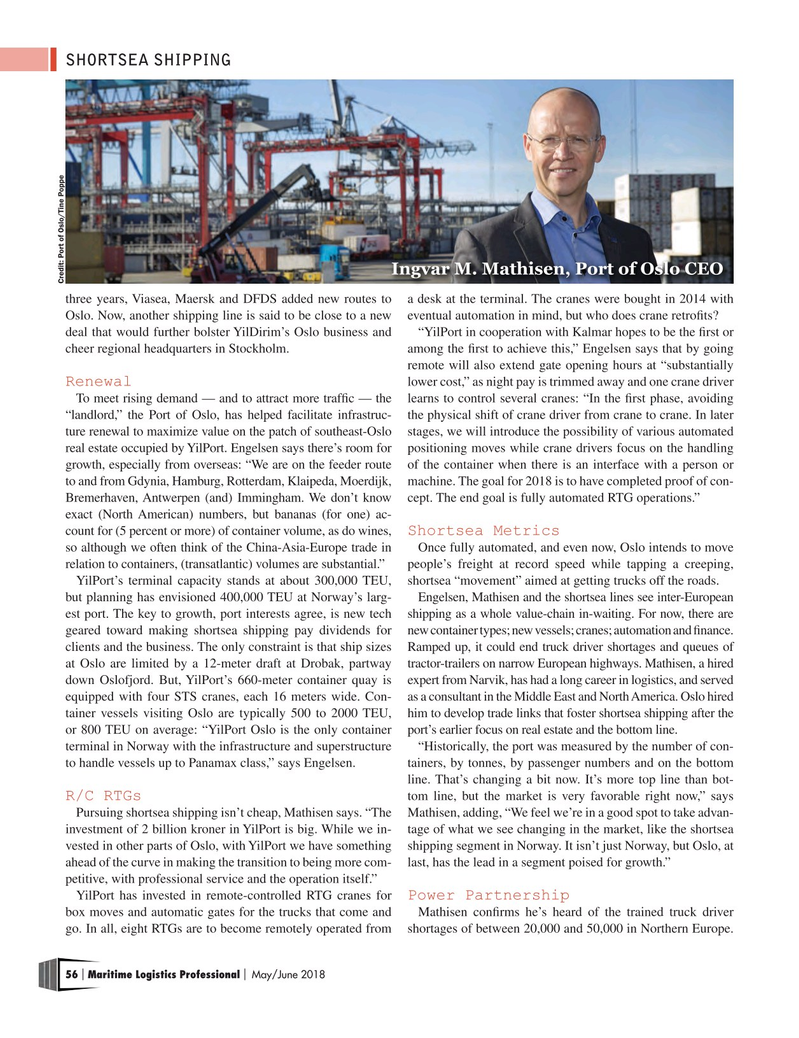
Page 56: of Maritime Logistics Professional Magazine (May/Jun 2018)
Container Ports
Read this page in Pdf, Flash or Html5 edition of May/Jun 2018 Maritime Logistics Professional Magazine
SHORTSEA SHIPPING
Ingvar M. Mathisen, Port of Oslo CEO
Credit: Port of Oslo/Tine Poppe three years, Viasea, Maersk and DFDS added new routes to a desk at the terminal. The cranes were bought in 2014 with
Oslo. Now, another shipping line is said to be close to a new eventual automation in mind, but who does crane retrofts? deal that would further bolster YilDirim’s Oslo business and “YilPort in cooperation with Kalmar hopes to be the frst or cheer regional headquarters in Stockholm. among the frst to achieve this,” Engelsen says that by going remote will also extend gate opening hours at “substantially
Renewal lower cost,” as night pay is trimmed away and one crane driver
To meet rising demand — and to attract more traffc — the learns to control several cranes: “In the frst phase, avoiding “landlord,” the Port of Oslo, has helped facilitate infrastruc- the physical shift of crane driver from crane to crane. In later ture renewal to maximize value on the patch of southeast-Oslo stages, we will introduce the possibility of various automated real estate occupied by YilPort. Engelsen says there’s room for positioning moves while crane drivers focus on the handling growth, especially from overseas: “We are on the feeder route of the container when there is an interface with a person or to and from Gdynia, Hamburg, Rotterdam, Klaipeda, Moerdijk, machine. The goal for 2018 is to have completed proof of con-
Bremerhaven, Antwerpen (and) Immingham. We don’t know cept. The end goal is fully automated RTG operations.” exact (North American) numbers, but bananas (for one) ac- count for (5 percent or more) of container volume, as do wines, Shortsea Metrics so although we often think of the China-Asia-Europe trade in Once fully automated, and even now, Oslo intends to move relation to containers, (transatlantic) volumes are substantial.” people’s freight at record speed while tapping a creeping,
YilPort’s terminal capacity stands at about 300,000 TEU, shortsea “movement” aimed at getting trucks off the roads.
but planning has envisioned 400,000 TEU at Norway’s larg- Engelsen, Mathisen and the shortsea lines see inter-European est port. The key to growth, port interests agree, is new tech shipping as a whole value-chain in-waiting. For now, there are geared toward making shortsea shipping pay dividends for new container types; new vessels; cranes; automation and fnance. clients and the business. The only constraint is that ship sizes Ramped up, it could end truck driver shortages and queues of at Oslo are limited by a 12-meter draft at Drobak, partway tractor-trailers on narrow European highways. Mathisen, a hired down Oslofjord. But, YilPort’s 660-meter container quay is expert from Narvik, has had a long career in logistics, and served equipped with four STS cranes, each 16 meters wide. Con- as a consultant in the Middle East and North America. Oslo hired tainer vessels visiting Oslo are typically 500 to 2000 TEU, him to develop trade links that foster shortsea shipping after the or 800 TEU on average: “YilPort Oslo is the only container port’s earlier focus on real estate and the bottom line. terminal in Norway with the infrastructure and superstructure “Historically, the port was measured by the number of con- to handle vessels up to Panamax class,” says Engelsen. tainers, by tonnes, by passenger numbers and on the bottom line. That’s changing a bit now. It’s more top line than bot-
R/C RTGs tom line, but the market is very favorable right now,” says
Pursuing shortsea shipping isn’t cheap, Mathisen says. “The Mathisen, adding, “We feel we’re in a good spot to take advan- investment of 2 billion kroner in YilPort is big. While we in- tage of what we see changing in the market, like the shortsea vested in other parts of Oslo, with YilPort we have something shipping segment in Norway. It isn’t just Norway, but Oslo, at ahead of the curve in making the transition to being more com- last, has the lead in a segment poised for growth.” petitive, with professional service and the operation itself.”
YilPort has invested in remote-controlled RTG cranes for
Power Partnership box moves and automatic gates for the trucks that come and Mathisen confrms he’s heard of the trained truck driver go. In all, eight RTGs are to become remotely operated from shortages of between 20,000 and 50,000 in Northern Europe. 56 Maritime Logistics Professional May/June 2018 | |

 55
55

 57
57
